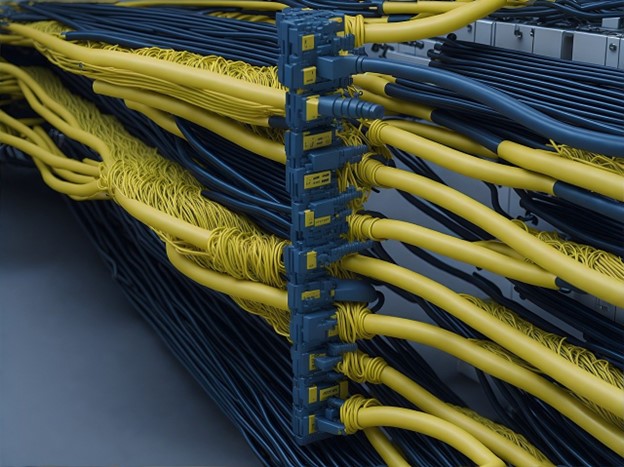Home / Handy Tips /

Image by Pete Linforth from Pixabay
Image Alt: Network cables
Yes, it’s crucial for any business that relies on robust and efficient communication and data management systems.
Whether you’re a small startup or a large enterprise, understanding the importance of structured cabling can be a game-changer for your business’s operational efficiency and future growth.
Hence, this article explores this need, focusing on the benefits, the problems it solves, and how structured scaling supports various technological needs.
Business Applications of Structured Cabling
Structured cabling is a comprehensive system comprising many components, including cables, patch panels, and trunking, organized into a hierarchical design.
Such a system serves as a critical foundation for a wide range of business applications, including the following:
Data Center Operations
Structured cabling is vital for data centers, which require highly reliable and efficient network infrastructure to manage vast amounts of data. The standardized data cabling helps organize and manage multiple data flows, ensuring optimal connectivity and minimizing the risk of data transmission errors or losses. Therefore, this is crucial for businesses that depend on real-time data access and processing, such as financial institutions and e-commerce platforms.
Voice and Video Communications
As businesses increasingly rely on VoIP (Voice over Internet Protocol) and video conferencing to connect with clients and remote employees, structured cabling provides the bandwidth and speed to handle these high-demand communications without lag or disruption. It supports collaboration and communication across different geographical locations, enhancing productivity and operational efficiency.
Building Management Systems (BMS)
Structured cabling integrates various systems within a building, including security, lighting, HVAC, and fire alarms, into a single network. This integration allows for centralized control and monitoring, which improves the management of building resources and enhances security measures, ultimately leading to reduced operational costs and increased safety.
Wireless Network Expansion
With the increasing need for mobility within business environments, structured cabling supports the expansion of wireless networks. It provides the backbone for Wi-Fi systems, ensuring access points are effectively connected and distributed throughout the premises for full coverage. This setup enables employees to move freely around the workspace while maintaining constant connectivity to the network.
Supports Multimedia and Virtual Reality (VR) Applications
For industries that utilize multimedia and VR, such as marketing, design, and training sectors, structured cabling ensures the fast data transfer rates required for these technologies. This capability allows businesses to offer innovative services and experiences that differentiate them from competitors and enhance customer engagement.
The Benefits of Structured Cabling
Scalability
Structured cabling systems accommodate growth and change, making them an invaluable asset for businesses planning for expansion. With its modular setup, adding new devices or technologies is straightforward, minimizing disruptions and the need for extensive downtime. This adaptability ensures that as business needs intensify or change, the infrastructure can scale accordingly, supporting additional data loads, more users, and new applications.
Reduced Downtime
A well-implemented structured cabling system minimizes the risks of downtime and network failures often associated with disorganized or haphazard cabling infrastructures. Further, a system with standardized elements and no cable spaghetti allows technicians to troubleshoot and rectify issues more quickly and accurately.
In addition, such an organization reduces the likelihood of human error during maintenance and upgrades, a common cause of network disruptions.
Simplification
Managing a unified structured cabling system is significantly simpler than dealing with multiple, different wiring infrastructures. This simplification stems from having a standardized way to connect devices and services throughout the entire building or campus, which reduces complexity.
Additionally, this uniformity allows for a cleaner, more organized physical layout of cables, which enhances safety and aesthetics while simplifying the identification and resolution of issues.
Choosing the Right Cabling Infrastructure for Your Business
The following are considerations to make when selecting your structured cabling infrastructure:
Assess Current and Future Needs
This assessment should consider the number of users, the type of data to handle, and potential expansions or technological upgrades. For instance, if your company expects to increase its workforce or adopt high-bandwidth applications shortly, opt for advanced CAT6 or fiber optic cables to accommodate these needs.
Understand Different Cabling Types
Choose a cabling type based on the speed, bandwidth, and environmental factors you may encounter. For example, CAT5e cables are generally sufficient for basic office networking, while CAT6 offers higher bandwidth and is better for environments with potential interference issues, such as industrial settings. Fiber optic cables provide the highest speeds and are essential for data-intensive operations or long-distance communications.
Consult Professionals
IT professionals or consultants who specialize in structured cabling can provide insights into the best practices in cabling infrastructure and help design a system tailored to the specific needs of your business. They can also ensure compliance with industry standards and local regulations for safety and efficiency.
Budget Allocation
While budget constraints are often a primary concern, structured cabling is a long-term investment. Opting for cheaper, lower-quality cables might save money initially but can lead to higher maintenance costs, more frequent outages, and costly upgrades down the line. As such, allocating a realistic budget by considering both initial and long-term operational costs will lead to a more sustainable infrastructure.
Conclusion
Investing in structured cabling enhances your communication and data management capabilities and secures a competitive edge in an increasingly digital marketplace. It allows for smoother operations, easier maintenance, and less downtime.
When you analyze the costs, there is a clear return on investment. Therefore, implementing structured cabling is a strategic investment.







Leave A Comment